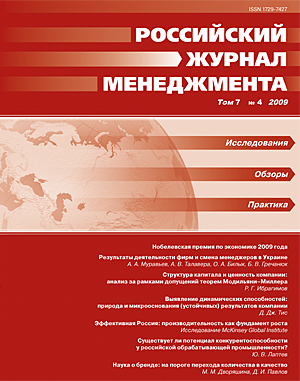Структура капитала и ценность компании: анализ за рамками допущений теорем Модильяни–Миллера
Аннотация
В статье представлена обобщенная модель влияния долгового финансирования на структуру и стоимость капитала компании, требующая выполнения существенно меньшего количества исходных допущений, по сравнению с классическими моделями Модильяни–Миллера и Майлза–Иззеля. Показано, что известные в корпоративных финансах формулы для расчета стоимости капитала компании с долговой нагрузкой выводятся как частный случай обобщенной модели при введении дополнительных условий.
Ключевые слова:
стоимость капитала, структура капитала, WACC, финансовая модель, оценка бизнеса
Скачивания
Библиографические ссылки
REFERENCES IN LATIN ALPHABET
Загрузки
Опубликован
Как цитировать
Выпуск
Раздел
Лицензия
Статьи журнала «Российский журнал менеджмента» находятся в открытом доступе и распространяются в соответствии с условиями Лицензионного Договора с Санкт-Петербургским государственным университетом, который бесплатно предоставляет авторам неограниченное распространение и самостоятельное архивирование.





